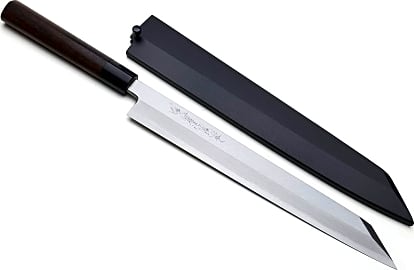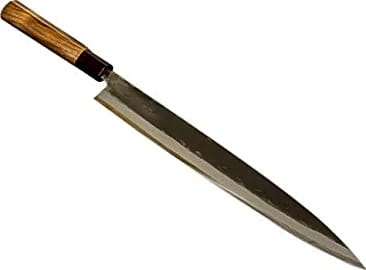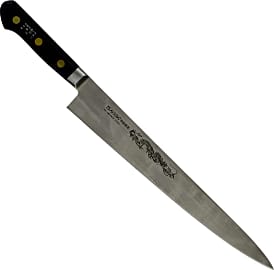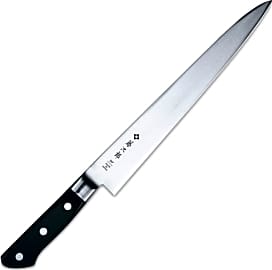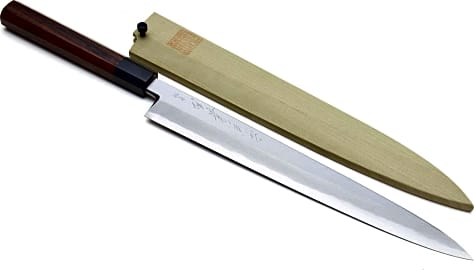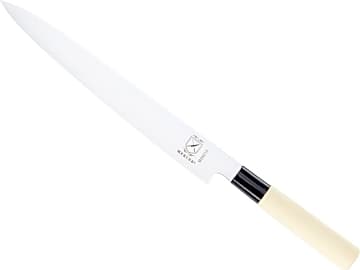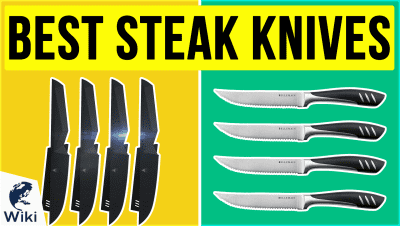The 10 Best Sushi Knives

This wiki has been updated 25 times since it was first published in October of 2018. For many, there are few foods more enjoyable than expertly-prepared sushi and sashimi, but they can both be very pricey when eating out. Whether you settle on a yanagi-ba, kiritsuke, takobiki, or general-purpose sujihiki slicer, one of these premium knives will help you make your favorite raw fish dishes right in the comfort of your own home, and for a fraction of what they cost at a restaurant. When users buy our independently chosen editorial recommendations, we may earn commissions to help fund the Wiki.
Editor's Notes
October 22, 2020:
The type of knife most commonly associated with sushi is called the yanagi-ba, which is generally quite long, as well as thin, light, absurdly sharp, and designed with a single-bevel edge that's especially suited to preparing premium nigiri from fish filets that have already been prepped and deboned. The Yoshihiro Kasumi is a clear winner in this traditional style, thanks to its renowned handmade craftsmanship, length, fit and finish, and use of the White #2 alloy that many trained chefs prefer. The Yoshihiro Yanagi is every bit as high-quality, and uses the Blue #2 alloy that has some positive and negative tradeoffs vs the White alloys. On the slightly less expensive side, the Tojiro F-1059 is still definitely a high performer, and its price-to-performance ratio is even better when you consider its 300-millimeter blade.
There are also a couple different subtypes of yanagi-ba. One is represented here by the Yoshihiro Takobiki, and you can tell that it's a specialty knife due to its reverse-angle tip, which is specifically intended for cutting the rubbery flesh of an octopus. The Yoshihiro Hongasumi, on the other hand, is called a kiritsuke yanagi-ba, and it's a bit heavier than the normal variety, which can make it easier to cut through some substances.
However, the yanagi-ba is not the only type of sushi knife, and unless you're dead set on making nigiri, you might be well-served to get something that's more versatile, which means, just about anything that has a double bevel. Furthermore, single-bevel knives have a noticeable learning curve as compared to common chef's knives, so a yanagi-ba isn't the best idea for most beginners.
The Misono Sujihiki is the simplest and easiest to care for of the double-bevel slicers, while the Misono Swedish slicer is a bit harder to keep from rusting, but offers a superior edge. For what it's worth, Misono also makes a variety of even more popular knives using those same two high-quality alloys.
One last thing that you may notice is that almost all of these are extremely expensive. Because sushi knives aren't in huge demand, their base prices tend to be higher. Another unfortunate part of buying kitchen knives is that it can be hard to wade through all the no-name knock-off brands, and buying the cheapest sushi knife available might not be the best idea. The Mercer Culinary Sashimi is generally the best choice for a budget-friendly model, but if you'll be using it a lot, we highly recommend taking a step up to one of the Tojiros, or better.
November 09, 2018:
Many knives on the market claim to made for making sushi, but the Japanese and professional chefs know that only single-beveled blades should be used for preparing raw fish in this traditional style. For that reason, we discounted any knife that didn't feature a single-bevel design. From that point, we did our best to include as many handcrafted models as possible, while still making sure to add a few lower cost options for the amateur home cooks.
Special Honors
Takeda Hamono Takeda-san and his apprentices are true craftsmen, and their talent is apparent when holding any of their truly high-end pieces. The Yanagiba is, of course, highly recommended knife for true sushi enthusiasts, and in our experience, the 21-centimeter Sasanoha Gyuto is one of the lightest and most special blades of any type on the market. takedahamono.com



